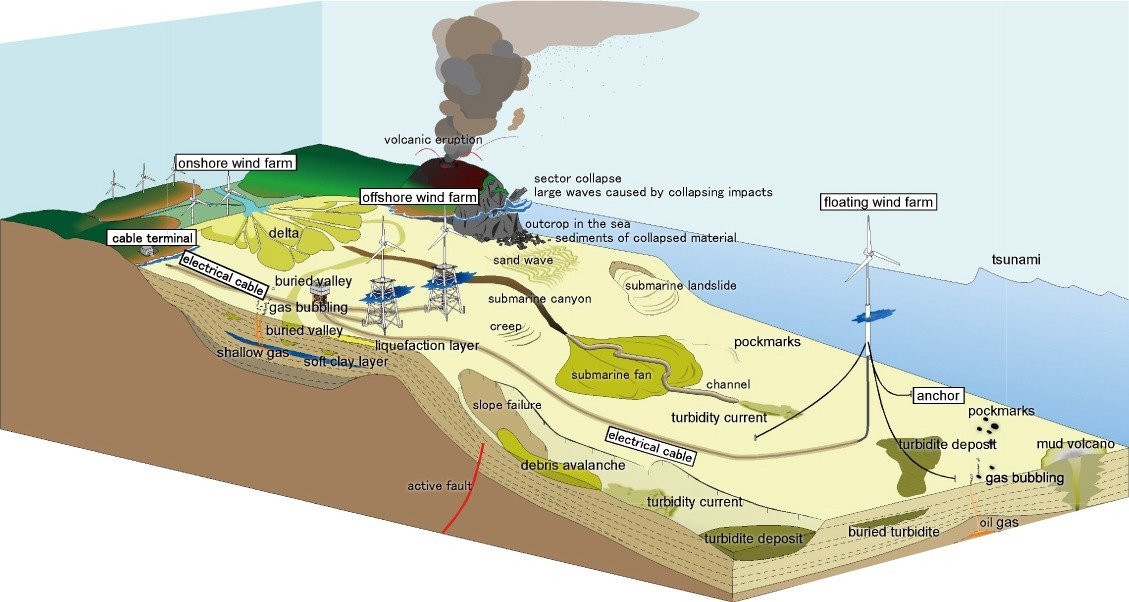Scientific Rationale

Submarine geohazards and risks to offshore renewable energy developments on continental shelves and submarine slopes.
Submarine Geohazard Risks
The recurrence cycle for large-scale geohazards, including volcanic eruptions, earthquakes, and tsunamis, is frequent: 50 to 100 years. Continental shelves and submarine slopes in steep-sided and tectonically active areas are at high risk from numerous submarine geohazards, including seabed liquefaction, seabed creeps, submarine slides, turbidity currents, shallow gas eruptions, mud volcanoes, seabed sand wave migrations, and scour and erosion around marine and offshore infrastructures. Global warming in recent years has intensified typhoons, hurricanes, and cyclones, increasing the demand for submarine geohazard risk assessment for coastal zone development.
There are numerous facilities along the coast, both on and offshore, which are constantly under threat from natural hazards. They include: major centers of population and industry; renewable energy systems, such as offshore wind farms, nuclear power plants, associated grid connections; international commerce and telecommunications, etc. In geologically active regions, the presence of mountain range close to the coast often force settlement, road and rail roads to be located near or at the coastline, so exposing them to marine geohazard. The life cycle of offshore renewable energy developments involves design and development, site selection, obtaining various permissions, facility manufacturing, installation, operation and maintenance, to final decommissioning. A significant proportion of costs on power generation come from the design and installation of foundations and then ongoing maintenance of sites. Government funded geological and geophysical data archives of submarine environments and geohazards, which help to characterize risks, are publicly accessible but are rarely complete or integrated internationally. Additional industry funded investigations may be essential on governmental requirements for pre-installation Environmental Impact Assessment surveys. Moreover, survey data needs expert interpretation to identify potential hazards. Yet for the offshore renewable energy sector, there are no guidelines on requirements needed to identify submarine geohazard risks to a given confidence level so that the development of global guidance and marine geological expertise could help to de-risk investment on offshore developments.
Offshore renewable energy systems are rapidly advancing to meet global requirements for clean energy growth. Market leadership, in terms of installed capacity, is currently centered in Northwest Europe. In Europe offshore wind has the potential to be the main source of renewable energy. The marine geology of Northwest Europe is characterized by predominately wide, shallow, tectonically stable seafloor. Coupled with a high wind power density, Northwest Europe has been the testbed to accelerate offshore renewable technology solutions, development, and sector growth. The seabed is, however, subjected to diverse forms of submarine geohazard risks owing to intensified environmental forcing under global climate change, amid an increase in needs for further offshore development.
Many other regions are now considering offshore renewable energy solutions, including Southern Europe, South and Southeast Asia, South and North America and Oceania. In contrast to Northwest Europe, the marine geology of many of these regions are plate subduction zones or transform plate boundaries that are characterized by narrow, topographically steep and tectonically active seafloor. Here the continental shelf is narrow and the space for conventional offshore development is limited. Exclusive economic zones for offshore development are predominately composed of deep marine environments, with water depths >100m. New technologies and solutions are therefore required for offshore development to grow to meet global demand.
Continental shelves and submarine slopes including convergent and transform plate boundaries are at risk from numerous geohazards. Large-scale geohazards include volcanic eruptions, earthquakes, and tsunamis (either earthquake- and landslide-induced). The recurrence cycle for large-scale events is frequent, 50 to 100 years, within the expected lifespan of existing windfarms or other offshore infrastructures. In addition to the large-scale geohazards, offshore renewable energy systems that are generally installed at water depths of up to 200m are at increasing risk from numerous submarine geohazards, including seabed liquefaction, seabed creeps, submarine slides, turbidity currents, shallow gas eruptions, mud volcanoes, large scale sand wave movements and scour and erosion around marine and offshore structures. These natural activities could cause damages and failures in offshore renewable energy systems, from foundations to arrays and export cables. With the transition to clean energy solutions, these submarine geohazards pose risks to power supply at regional and global levels.
A study of submarine geohazard risks to offshore renewable energy systems is therefore essential for global sustainable development. To secure clean energy futures globally, integrated international advancement on geological data and research are necessary to understand and assess both low-magnitude, high frequency and high-magnitude, low(er)-frequency submarine geohazards to offshore renewable system installations (Figure 1). In this context, academic, governmental, and industrial strategies to manage and mitigate risks are required.
タグ:TGSG


